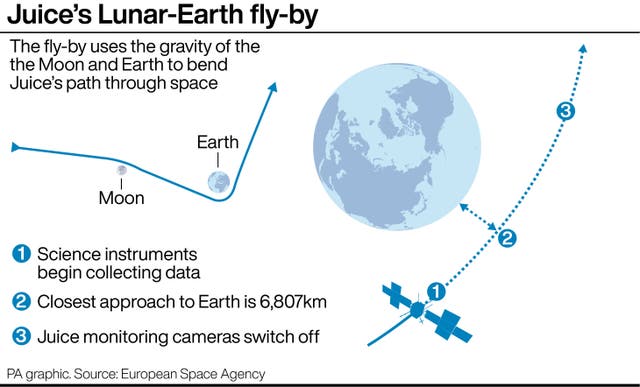New “breathtaking” images of the moon have been beamed back to Earth from the European Space Agency’s (ESA) Juice mission.
On Monday night the spacecraft began performing a the first ever fly-by of its kind on a shortcut to Jupiter via Venus.
First it used the moon’s gravity, and then on Tuesday night it will use the Earth’s, as a natural brake – slowing itself down and then sling-shotting on to the next phase of its journey.
Sometimes the journey is just as worthy as the destination🌑
As humankind embarked on the monumental first lunar-Earth flyby, @ESA's Jupiter Icy Moons Explorer (Juice) mission captured a breathtaking glimpse of our natural satellite.
At 23:15 CEST on 19 August 2024, the left… pic.twitter.com/wxw5lYsnx5
— Josef Aschbacher (@AschbacherJosef) August 20, 2024
During this risky manoeuvre, Jupiter Icy Moons Explorer (Juice) managed to capture some pictures of the moon.
They show some sign of real colour differences in the large-scale features on the lunar surface.
Another image shows Earth photobombing the moon, appearing as a dark circle outlined by a light crescent at the top centre of the image, peeking out from behind the spacecraft structure.
It is visible just above a fuzzy blue blob, which itself is a ghost image caused by reflection of sunlight.

ESA director general, Josef Aschbacher, said on X, formerly known as Twitter, said: “Sometimes the journey is just as worthy as the destination.
“As humankind embarked on the monumental first lunar-Earth fly-by, ESA’s Jupiter Icy Moons Explorer (Juice) mission captured a breathtaking glimpse of our natural satellite.”
The successful fly-by of the moon slightly redirected Juice’s path through space to put it on course for a fly-by of Earth.
It is expected to reach its closest distance from the planet (6,840km, or 4,250 miles) at around 10.56pm on Tuesday.

The Juice monitoring cameras were designed to monitor the spacecraft’s various booms and antennas, especially during the challenging deployment period following launch.
They were not designed to carry out other scientific research or take images of the moon.
A scientific camera called JANUS is providing high-resolution imagery during the cruise phase fly-bys of Earth, the moon and Venus, and of Jupiter and its icy moons once it is in Jupiter’s system in 2031.
The mission launched in April 2023 on a 4.1 billion-mile journey to Jupiter which will take more than eight years.
Onboard are 10 scientific instruments, including from the UK, which will investigate whether the gas giant’s three moons – Callisto, Europa and Ganymede – can support life in their oceans.




Comments: Our rules
We want our comments to be a lively and valuable part of our community - a place where readers can debate and engage with the most important local issues. The ability to comment on our stories is a privilege, not a right, however, and that privilege may be withdrawn if it is abused or misused.
Please report any comments that break our rules.
Read the rules here